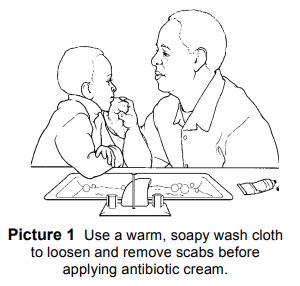Impetigo

Impetigo (imp e TIE go) is a common skin infection caused by bacteria (germs). Sores can appear around the mouth or nose, neck, hands or diaper area. They often form where the skin is broken or irritated. This can be due to a cut, scrape, rash or insect bite. Impetigo is more common during the warmer months and in children 2 to 5 years old.
Impetigo starts as one or more discolored pimples that turn into fluid-filled blisters. The blisters quickly break open, ooze clear liquid and form honey-colored crusts or scabs. The sores can be itchy. The skin around them is red.
Bacteria live under the scabs. When the scabs break, germs can spread to other parts of the body and to other people.
Treatment
If there are only a few sores, impetigo is easy to treat with soap, water and a prescription antibiotic cream. They often go away within a week of starting treatment.
- Wash your hands before starting. If you can, wear gloves.

- Use a warm, soapy washcloth or compress to loosen the crusts. Gently remove them (Picture 1). The area may bleed a little. This is OK. It is very important to remove all the crusts so the antibiotic ointment can get through to kill the germs.
- Apply the cream to each sore and the area of skin around the sore. Start from the outside area and work to the center of the sore. Rub the ointment in well.
- Cover the area loosely with gauze or a Band-Aid®. This helps air to get to the area and prevents your child from touching and spreading the germs.
- Wash your hands well when you are finished.
- Repeat these steps 2 to 3 times a day.
If a large number of sores have spread over the body, your child may also be given a prescription for an antibiotic to take by mouth. It is very important to take all the medicine as ordered, even after the sores have improved. When antibiotics are not used correctly (such as taking too much, missing doses or not finishing a prescription), the infection may come back. The germs may also develop resistance. Resistance can make infections very hard to treat. Sometimes they cannot be treated at all.
Other Advice
- Do not use the kitchen sink for cleaning the sores. Wash the bathtub and sink well after each use.
- Wash towels, washcloths and bed linens after each use.
- Any clothes that may have touched the bacteria should be washed.
- Washcloths, towels, bed linens or clothes should not be shared with anyone else.
- If your child seems to be itching at night, have him or her wear cotton mittens or socks on his hands to prevent scratching.
- Keep fingernails cut short.
To Prevent the Spread of Impetigo
- Tell your child not to touch or pick at the sores. Every time your child touches the impetigo and then scratches another part of the skin or touches another person, a new area of impetigo can get started.
- Have your child wash his hands often with soap and water.
- Impetigo heals faster if left uncovered. But, if your child picks at the sores, keep them covered. Open, draining sores should be covered with a loose bandage.
- Keep your child out of school until he has been using the antibiotic ointment or taking the antibiotic by mouth for 24 hours.
When to Call the Doctor
Call your doctor if the sores have not improved in 2 or 3 days or if the sores spread rapidly.
HH-I-46 10/75, Revised 11/17, Copyright 1975 Nationwide Children’s Hospital


